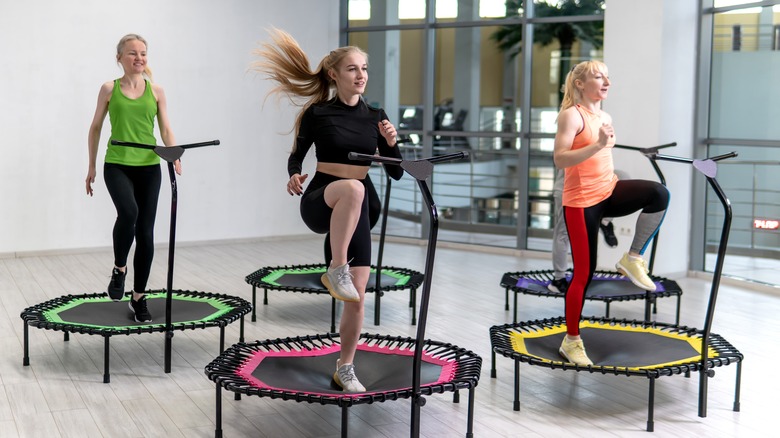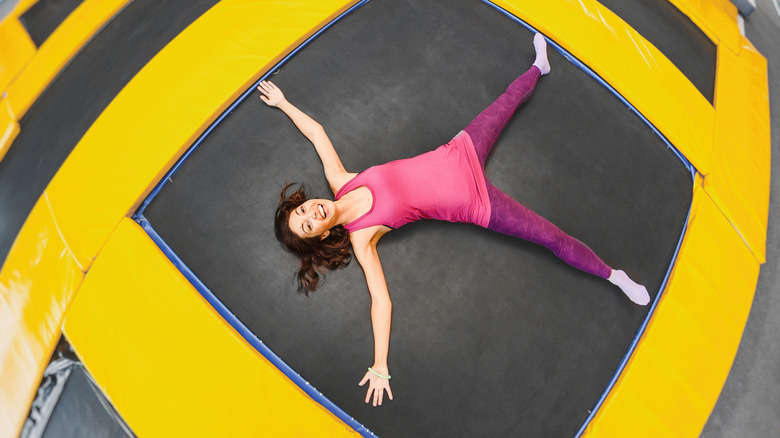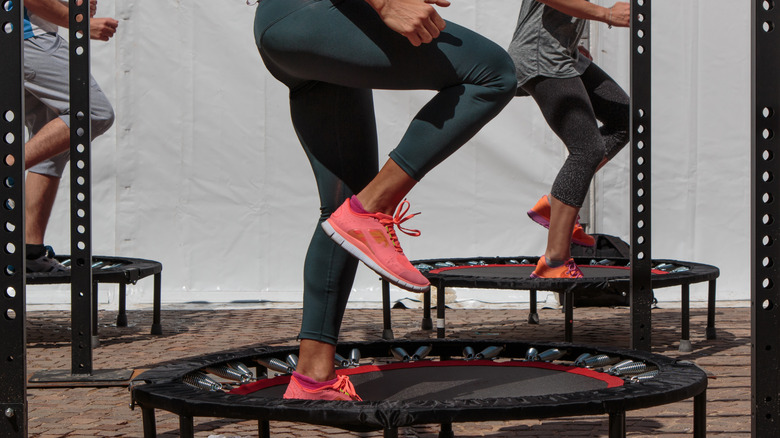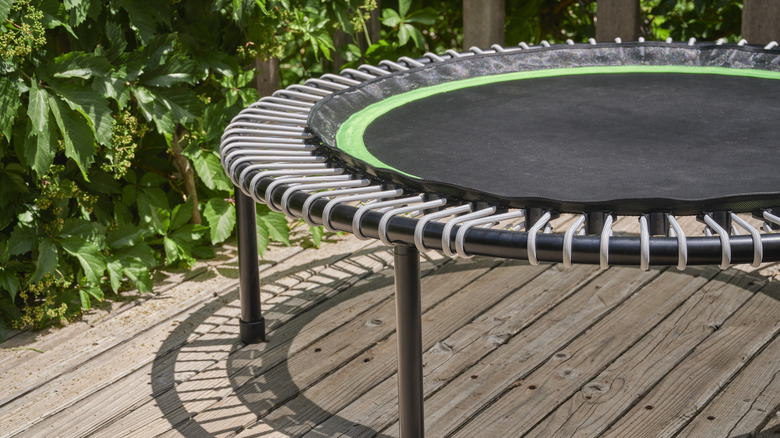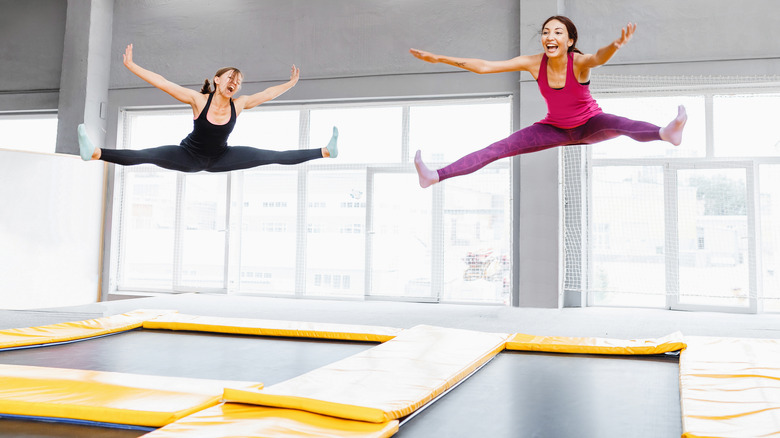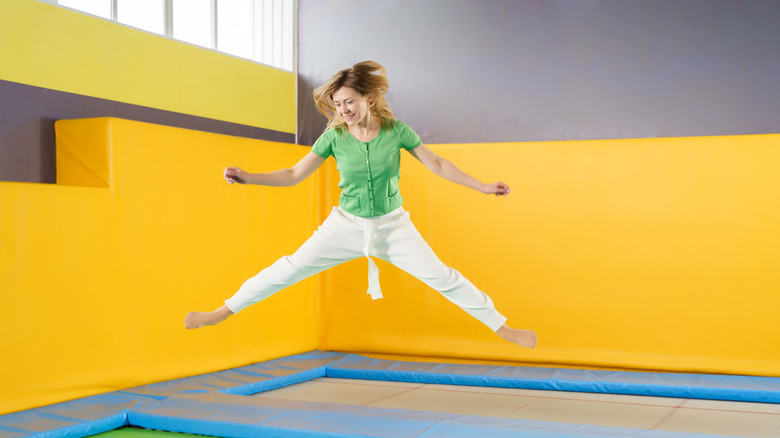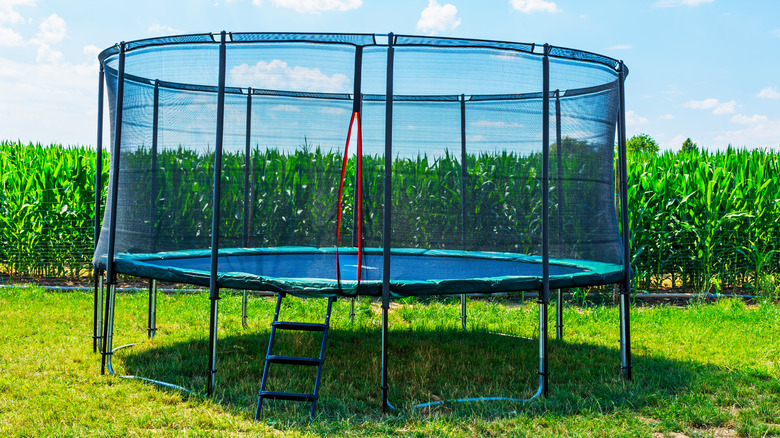The Great Trampoline Revival: How The Exercise Tool Is Shaping Workouts In 2023
When you consider how much fun it is to jump on a trampoline, it's easy to forget it's a form of exercise. People have been jumping on trampolines since the 1940s, thanks to a 16-year-old gymnast named George Nissen. Trampolines are still used by gymnasts today — even in the Olympics.
Over time, the tool has evolved into an indoor exercise option, an indoor adventure park attraction, and an outdoor piece of equipment for jumpers of all ages. Some astronauts use them for training. According to The Canberra Times, a NASA study revealed that trampoline jumping "is the most efficient, effective form of exercise yet devised."
PureWow predicts trampoline jumping will be one of 2023's most popular workouts — partially based on the 2022 opening of House of Air Trampoline Park and Café, a San Francisco trampoline studio. This California studio isn't the only one. Many exist throughout the country. Trampoline jumping has been shaping workouts in America and beyond — thanks to its reported health benefits.
Cardiovascular benefits of trampoline jumping
Trampoline jumping is an aerobic exercise that grants cardiovascular benefits. Jumping increases your heart rate — not unlike running, cycling, power walking, or jumping rope. Over time, performing cardio exercises on a regular basis strengthens the heart and reduces blood pressure levels.
Remember, the heart is a muscle. Just as it's beneficial to have strong quads, hamstrings, core muscles, and biceps, it's beneficial to have a strong heart. Having a healthy heart not only decreases your blood pressure but it lowers heart disease risks and cholesterol levels. As Edward-Elmhurts Health explains, cardio workouts help your overall workout efficiency.
If you're new to trampoline jumping, you may find that you tire quickly after just a short while. But the more you do it, the more your heart will adjust. The more the heart adjusts, the easier it will be to jump up and down without feeling winded.
Weight loss benefits of trampoline jumping
Any cardio exercise can contribute to weight loss, including trampoline jumping. Throughout the day and night, the body burns calories naturally. But when you're jumping, the calorie burn occurs at a much faster rate. If you burn more calories than you consume every day, it's likely you'll lose weight — although it's worth noting that our metabolisms differ for a variety of factors.
Although any form of exercise can contribute to weight loss, the activity's intensity is a key factor in determining how many calories will be burned. The higher the intensity, the greater the calorie burn. With trampoline jumping, you'll need to jump at a moderate to vigorous intensity level if you want to burn more calories in a short amount of time.
Chron. claims that a 135-person burns about 145 calories during a low-intensity trampoline workout. The average 150-pound person would burn about 15 more calories for the same low-intensity workout. At higher intensity, the calorie burn total would overall be greater.
Mental benefits of trampoline jumping
Perhaps the most fun benefit of trampolining is the pleasure that comes with the activity — whether done solo or with a group of friends. Whether you're 29 or 79, jumping on a trampoline can be enjoyable for all ages. This "fun factor" can then result in a domino effect of other benefits. Having a good time is a major stress reliever. Reducing stress can help improve the quality of your sleep, lower your blood pressure, and improve your overall mood.
Speaking of mood, did you know exercise alone can trigger endorphins? These hormones are responsible for making you feel happy and can increase your satisfaction levels day-to-day (via Mayo Clinic). So when you jump on a trampoline for a longer period of time, it triggers these hormones to release into your bloodstream. Fun, stress relief, plus being put in a good mood...what's not to love?
Muscles worked during trampoline jumping
Since you obviously need your legs to jump, trampoline jumping activates various leg and butt muscles, including the gluteus maximus, hamstrings, quadriceps, and calves. Core muscles are also used for stability, and the back, arm, and shoulder muscles are used to help you get more height with each jump.
Although these muscles are activated with every jump, it doesn't mean you'll build a lot of muscle mass. Building muscle mass requires resistance — such as with lifting weights. Jumping on a trampoline doesn't involve any resistance. You can, however, strengthen and tone these muscles, which can help you effectively perform other exercises. If your goal is to build noticeable muscle — not just tone — perform squats on the trampoline. You can also do weighted exercises off the trampoline and rotate with jumping for a cardio and strength training workout.
Trampoline options
There's a variety of trampoline types to choose from if you're looking to purchase one. If you plan to use it for acrobatic or gymnastic activities, you'll need a large one. Unless you have a large indoor space with a high ceiling, you'll need to place it outdoors. Shapes come in square, rectangular, circular, oval, or octagonal. They also come in different sizes, ranging from eight to 16 feet.
If you don't have the space or prefer a smaller version, a fitness trampoline — also known as a rebounder — would be your best option. These are much smaller and much closer to the ground. Some offer handles, so you can hold on as you jump. Others come with bands attached to add some resistance training to your workout. Fitness trampolines are typically round in shape, but you can also find hexagonal and rectangular options. The most common size for these smaller trampolines is about three feet.
Unlike large, outdoor trampolines, many fitness trampolines come with foldable handles — allowing for more convenient, space-saving storage. This is especially convenient if you live in a small apartment and want to store your trampoline under your bed or in a closet when not in use.
Trampoline exercises
Whether you're new to trampoline jumping or you're an advanced jumper, there's a variety of trampoline exercises for rebounders and large trampolines. However, larger trampolines offer more options because you have more space to work with and a larger area to land moves like flips.
In addition to basic jumping, you can twist your body from side to side with each jump for a core workout. You can also do jumping jacks and back-and-forth jumps. With this latter option, place one foot forward as you jump. Then switch feet on the second jump and repeat this pattern. Swing your arms to help you stay balanced. Two other moves that you can do on any trampoline are a side-to-side jump and butt-kicks to build strong glute muscles.
With a larger trampoline, you can do a lot more — like jump pikes and tucks. As long as you keep safety in mind, you can make up your own exercises and even dance routines mid-air.
Trampoline jumping is a low-impact, high-intensity workout
Just as the phrase implies, "low impact" means you're putting less impact on the joints than with other exercises. High-impact examples include running, jumping jacks, and other types of ground-jumping exercises. Low-impact exercise examples include bicycling, rowing, swimming, and elliptical training.
Trampoline jumping is considered low-impact because the mat, along with the springs, absorbs the shock that hard surfaces don't. In fact, Springfree Trampoline claims it absorbs 80% of it. That means your knees and feet will feel much more comfortable jumping for 20 minutes straight on a trampoline surface rather than jumping on a mat on a concrete floor.
But despite being a low-impact exercise, trampoline jumping is high-intensity. It can get your heart rate up pretty quickly if you're jumping consistently, so you get the best of both worlds. Plus, with its high-intensity nature, you can incorporate intervals for a HIIT workout!
Safety tips for trampoline jumping
If you use a large trampoline outside, make sure the ground underneath it is level. Check that there isn't anything underneath the trampoline. It should be placed on the grass or a similarly soft and even surface. If you're installing it indoors, the same recommendations apply. Consider installing a safety net around the trampoline, especially if you allow children to use it.
When you jump on a large trampoline, you should always aim for the center of the trampoline, as this will lower or eliminate the risk of falling off the edge. Obviously, you won't have to worry about this with a mini trampoline. In general, there are fewer risks involved with the smaller trampoline options.
In terms of the number of jumpers, you've probably seen many backyard trampolines with five jumpers at a time. Perhaps you were one of those five jumpers when you were a kid. While it is possible to have multiple people on a trampoline without an injury occurring, the opposite is also likely. More jumpers carry a greater risk of injury. Use your discretion when deciding whether or not to let someone else jump with you. If you follow these tips, you can safely perform a range of exercises and reap the benefits of trampoline jumping for years to come!
